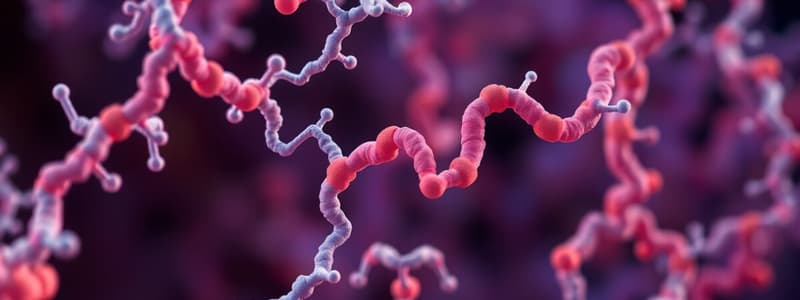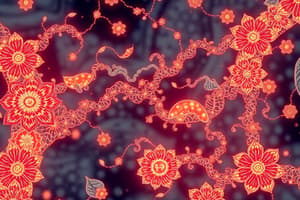Podcast
Questions and Answers
What is the primary role of protein phosphorylation in cellular processes?
What is the primary role of protein phosphorylation in cellular processes?
- It prevents protein-protein interactions.
- It transduces information along protein cascades. (correct)
- It initiates protein translation.
- It modifies the structure of proteins permanently.
Which of the following statements about structural domains is true?
Which of the following statements about structural domains is true?
- Each structural domain has a unique protein folding structure.
- A single protein can contain multiple distinct structural domains. (correct)
- Domains are always identical in structure and function.
- Structural domains can only be found in signaling molecules.
What process contributes to the variability of structural domains in proteins?
What process contributes to the variability of structural domains in proteins?
- Transcription regulation
- Mutations and shuffling of exons (correct)
- Protein degradation
- Translation errors
Which of the following is an example of a catalytic domain?
Which of the following is an example of a catalytic domain?
What distinguishes PTB and SH2 domains from each other?
What distinguishes PTB and SH2 domains from each other?
How do cellular proteins interpret chemical modifications such as phosphorylation?
How do cellular proteins interpret chemical modifications such as phosphorylation?
What happens to the tetrameric structure of PKA when four cAMP molecules bind to its regulatory subunits?
What happens to the tetrameric structure of PKA when four cAMP molecules bind to its regulatory subunits?
Which of the following statements accurately reflects the nature of structural domains?
Which of the following statements accurately reflects the nature of structural domains?
Which domain is associated with enzymatic activity specifically related to removing phosphate groups?
Which domain is associated with enzymatic activity specifically related to removing phosphate groups?
What is the role of the protein interaction domains?
What is the role of the protein interaction domains?
What initiates the intracellular signaling process?
What initiates the intracellular signaling process?
Which mechanism is NOT involved in signal transduction cascades within a cell?
Which mechanism is NOT involved in signal transduction cascades within a cell?
How do structural domains of signaling proteins contribute to signal propagation?
How do structural domains of signaling proteins contribute to signal propagation?
What is the primary role of scaffold proteins in signaling pathways?
What is the primary role of scaffold proteins in signaling pathways?
What is the significance of non-covalent interactions between signaling proteins?
What is the significance of non-covalent interactions between signaling proteins?
Which of the following best describes protein-protein interactions in signaling cascades?
Which of the following best describes protein-protein interactions in signaling cascades?
What happens to the ligand-receptor complex upon binding?
What happens to the ligand-receptor complex upon binding?
Why is signal specificity important in intracellular signaling?
Why is signal specificity important in intracellular signaling?
What is the main characteristic of proline-rich sequences that SH3 domains interact with?
What is the main characteristic of proline-rich sequences that SH3 domains interact with?
Which of the following proteins is an example of a protein containing SH3 domains?
Which of the following proteins is an example of a protein containing SH3 domains?
Which type of domain binds to phosphotyrosine residues?
Which type of domain binds to phosphotyrosine residues?
What is a key function of PH domains in cellular processes?
What is a key function of PH domains in cellular processes?
What is the general role of Src family kinases in cellular processes?
What is the general role of Src family kinases in cellular processes?
Which protein is cited as an example of a PH-domain containing protein?
Which protein is cited as an example of a PH-domain containing protein?
In which structural conformation do Src family kinases become active?
In which structural conformation do Src family kinases become active?
Which domain is specifically associated with calcium binding?
Which domain is specifically associated with calcium binding?
What is the primary function of a PDZ binding motif?
What is the primary function of a PDZ binding motif?
Which of the following proteins is considered a PDZ-based scaffold protein?
Which of the following proteins is considered a PDZ-based scaffold protein?
What characterizes MAGUK proteins?
What characterizes MAGUK proteins?
Which of the following is a function of scaffold proteins?
Which of the following is a function of scaffold proteins?
Which scaffold protein is involved in the Drosophila melanogaster phototransduction cascade?
Which scaffold protein is involved in the Drosophila melanogaster phototransduction cascade?
Which domain is NOT found in MAGUK proteins?
Which domain is NOT found in MAGUK proteins?
What does the abbreviation 'MAGUK' stand for?
What does the abbreviation 'MAGUK' stand for?
Which protein is known as the Na H Exchanger regulatory factor?
Which protein is known as the Na H Exchanger regulatory factor?
What is the primary role of AKAP in cellular signaling?
What is the primary role of AKAP in cellular signaling?
Which of the following proteins directly interacts with phosphorylated receptors?
Which of the following proteins directly interacts with phosphorylated receptors?
Which kinases are non-covalently associated with cytokine receptors to initiate signaling?
Which kinases are non-covalently associated with cytokine receptors to initiate signaling?
How do STATs become activated after binding to the phosphorylated receptor?
How do STATs become activated after binding to the phosphorylated receptor?
What distinguishes cytokine receptors from receptor tyrosine kinases (RTKs)?
What distinguishes cytokine receptors from receptor tyrosine kinases (RTKs)?
What role does the COOH-terminal end of G-protein coupled receptors (GPCRs) serve?
What role does the COOH-terminal end of G-protein coupled receptors (GPCRs) serve?
Which domain of STATs is crucial for their binding to phosphorylated receptors?
Which domain of STATs is crucial for their binding to phosphorylated receptors?
Which of the following is NOT considered a signaling scaffold protein?
Which of the following is NOT considered a signaling scaffold protein?
Flashcards
Signal transduction
Signal transduction
The process by which cells receive and respond to signals from their environment.
Signaling proteins
Signaling proteins
Proteins that play a key role in receiving, transmitting, and amplifying signals within cells.
Structural domains
Structural domains
Specific regions within signaling proteins that allow them to interact with other proteins and participate in signal transduction.
Ligand-receptor interaction
Ligand-receptor interaction
Signup and view all the flashcards
Protein-protein interactions
Protein-protein interactions
Signup and view all the flashcards
Phosphorylation
Phosphorylation
Signup and view all the flashcards
Scaffold proteins
Scaffold proteins
Signup and view all the flashcards
Signal propagation
Signal propagation
Signup and view all the flashcards
Protein Modules
Protein Modules
Signup and view all the flashcards
Protein Phosphorylation
Protein Phosphorylation
Signup and view all the flashcards
PTB and SH2 domains
PTB and SH2 domains
Signup and view all the flashcards
Same Structure, Different Function?
Same Structure, Different Function?
Signup and view all the flashcards
Catalytic Domain
Catalytic Domain
Signup and view all the flashcards
Protein Kinase Domain
Protein Kinase Domain
Signup and view all the flashcards
Protein Phosphatase Domain
Protein Phosphatase Domain
Signup and view all the flashcards
How do mutations affect protein domains?
How do mutations affect protein domains?
Signup and view all the flashcards
SH3 domain
SH3 domain
Signup and view all the flashcards
Proline-rich sequence
Proline-rich sequence
Signup and view all the flashcards
What kind of binding surface does an SH3 domain have?
What kind of binding surface does an SH3 domain have?
Signup and view all the flashcards
PhosphoTyrosine Binding Domain
PhosphoTyrosine Binding Domain
Signup and view all the flashcards
How do PhosphoTyrosine Binding domains interact with membranes?
How do PhosphoTyrosine Binding domains interact with membranes?
Signup and view all the flashcards
PH domain
PH domain
Signup and view all the flashcards
What are the main types of domains for protein interactions?
What are the main types of domains for protein interactions?
Signup and view all the flashcards
PDZ-Based Scaffold Proteins
PDZ-Based Scaffold Proteins
Signup and view all the flashcards
Non-PDZ-Based Scaffold Proteins
Non-PDZ-Based Scaffold Proteins
Signup and view all the flashcards
AKAP
AKAP
Signup and view all the flashcards
JAK-STAT
JAK-STAT
Signup and view all the flashcards
β-Arrestin
β-Arrestin
Signup and view all the flashcards
Cytokine Receptor Signaling
Cytokine Receptor Signaling
Signup and view all the flashcards
G-Protein Coupled Receptors (GPCRs)
G-Protein Coupled Receptors (GPCRs)
Signup and view all the flashcards
PDZ binding motif
PDZ binding motif
Signup and view all the flashcards
What are scaffold proteins?
What are scaffold proteins?
Signup and view all the flashcards
Give an example of a PDZ-based scaffold protein
Give an example of a PDZ-based scaffold protein
Signup and view all the flashcards
Give an example of a non-PDZ-based scaffold protein
Give an example of a non-PDZ-based scaffold protein
Signup and view all the flashcards
What is the role of MAGUK Proteins?
What is the role of MAGUK Proteins?
Signup and view all the flashcards
What does the acronym MAGUK stand for?
What does the acronym MAGUK stand for?
Signup and view all the flashcards
What are the key features of MAGUK proteins?
What are the key features of MAGUK proteins?
Signup and view all the flashcards
Study Notes
Bioc 325: Lecture 2
-
Learning Objectives: Introduce signaling structural domains, their roles in signal propagation, and the importance of scaffold proteins.
-
Introduction: Intracellular signaling translates messages for cellular responses. The initial step involves ligand-receptor interaction causing conformational changes. Common mechanisms include protein-protein interactions and phosphorylation.
-
Protein-Protein Interactions: Signal propagation through the intracellular space requires protein interaction. It maintains signal specificity and occurs in a tightly controlled mode, not randomly. Protein interactions are restricted to authorized partners. Protein modules (interaction motifs) are key.
-
Protein Phosphorylation: A popular mechanism for transmitting information along cascades. It occurs when a protein kinase interacts with tyrosine, threonine, or serine residues on a protein which serves as a signal for activating or deactivating downstream events.
-
Part 1: Structural Domains:
- Domains are regions of similar architecture within proteins, serving as functional components.
- Domains are modular, repeating within a single polypeptide or recurring in various protein structures.
- Some domains have different structures but the same function (e.g., PTB and SH2 bind p-Tyr).
- Some domains have the same structure but different functions (e.g., PTB and PH).
- Most proteins contain at least two domains and signaling molecules often have more.
-
Structural Domains and Their Roles:
- Domains play key roles as functional components.
- Individual domains may not guarantee a specific function but may contribute to it.
- Exon mutations and shuffling affect a domain's function.
-
A: Catalytic Domains: Possess enzymatic activity. Examples include protein kinase domains (like PKA, PKC, RTKs) and phosphatase domains (like PTEN).
-
B: Protein Interaction Domains: Lack enzymatic activity. These provide interaction sites for other proteins. Examples include SH2 and SH3 domains.
-
Classification of Structural Domains: Domains are classified by their function in cellular signaling:
- Domains that bind to oligopeptide motifs (SH2, SH3, PTB)
- Phosphoinositide-binding domains (PH)
- Ca2+-binding domains (EF-hand and C2)
- Zinc finger domains (C2H2)
- Protein kinase domains
- PDZ domains
SH2 Domains
- Nomenclature: SH2 = Src homology region 2.
- Function: Protein interaction domains that bind to short motifs with phosphotyrosine.
- Examples: Receptor tyrosine kinases (RTKs), non-RTKs, phospholipase Cy (PLCγ), regulatory subunits of phosphoinositide 3-kinase (PI3K), and some protein tyrosine phosphatases (PTPs).
SH3 Domains
- Nomenclature: SH3 = Src homology region 3.
- Function: Protein interaction domains that bind to proline-rich sequences.
- Proline-rich Sequences: Typically consist of 8-10 proline residues, including at least two prolines in a PxxP motif.
- Hydrophobic Binding: SH3 domains have a hydrophobic binding surface.
- Examples: Adaptor proteins such as Grb2 and Nck.
PTB Domains
- Nomenclature: PTB = PhosphoTyrosine Binding.
- Function: Bind phosphotyrosine residues (N-P-X-pY), but recognize sequences that are quite distinct from SH2 domains.
- Phospholipid Binding: Also can bind acidic phospholipid head groups like those in phosphoinositides.
- Importance: Can translocate to membrane surfaces to encounter ligands.
- Example: PTB domain of insulin receptor substrate-1 (IRS-1).
PH Domains
- Nomenclature: PH = Pleckstrin Homology.
- Physiological Ligands: Phosphoinositides and βy-subunits of G proteins.
- Role: Involved in protein-protein interactions.
- Role: Example: Interaction of GRK2 (G-protein receptor kinase 2) with activated β-adrenergic receptors.
- Examples: pleckstrin, GRK2, PLC, Akt
Ca2+ binding motifs
- EF-hand motifs: Helix-loop-helix motifs that recognize and bind to calcium. Typically occur as adjacent pairs for enhanced function.
- C2 domains: Second conserved regulatory domain of PKCB, recognizing and binding to calcium.
Zinc Finger Domains
- C2H2 Domains: The largest zinc finger family, where zinc is coordinated by two cysteine and two histidine residues forming a stable complex.
Protein Kinase Domains
- Function: Catalytic domains with intrinsic activity. Examples are the catalytic subunits of PKA, PKC, RTKs
PDZ Domains
- Function: Bind to C-terminal residues of ion channels and receptors. Some can also bind to phosphoinositides. They help to anchor transmembrane proteins to the cytoskeleton and hold signaling complexes together.
Part 2: PDZ and Non-PDZ-based Scaffold Proteins
- Definition: Proteins that associate with two or more other proteins to enhance the efficiency and/or specificity of a cellular pathway.
PDZ-based Scaffold Proteins
- Specific examples include InaD, PSD-95, NHERF, and MAGUK proteins.
Non-PDZ-based Scaffold Proteins
- Specific examples include AKAP, JAK-STAT, and β-arrestin.
Studying That Suits You
Use AI to generate personalized quizzes and flashcards to suit your learning preferences.



